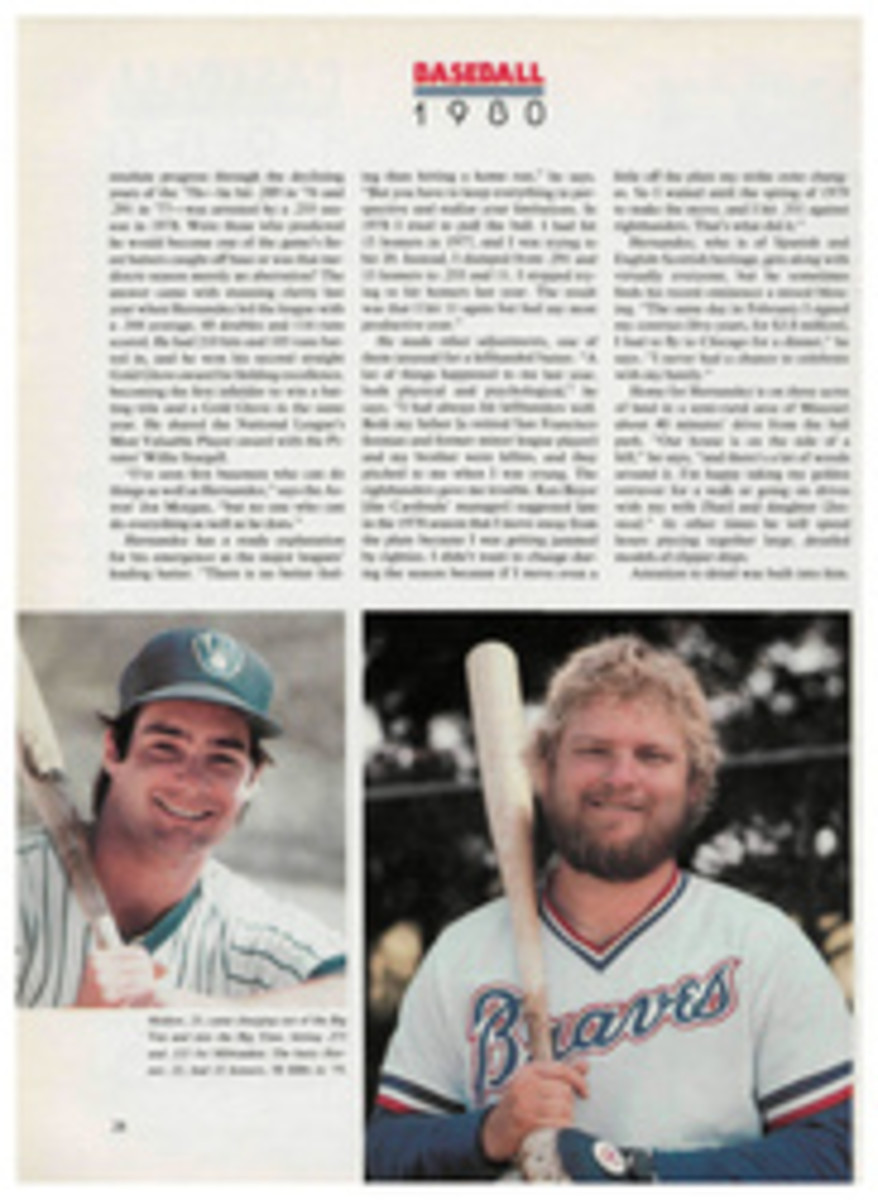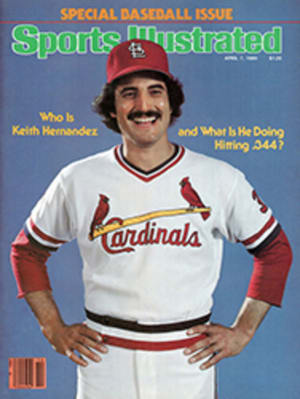
These numbers don't lie
Baseball fans love numbers. Sixty: the Babe's home runs. Fifty-six: Joe D's hitting streak. Five hundred eleven: Cy Young's career victories.
Perhaps the most impressive stat of all is .367, Ty Cobb's lifetime batting average. Over 24 seasons (1905-1928) Cobb hit at a pace that would have won every one but four of the 76 National and American League single-season batting championships since 1941.
Hitting a baseball is often called the most difficult endeavor in sports. The pitcher stands only 20 yards from the batter and throws the ball at speeds approaching 100 mph. He can make the ball veer in or curve away, shoot downward or explode upward. Yet the average major league batter, taking all this in and quelling whatever fears he may feel at the approach of the speeding ball, is able to get a hit slightly more often than once every four times at bat. Cobb's gifts were so extraordinary that he did it substantially more often than once every three times.
A batting average, times at bat divided into the number of hits, is not a measure of power—there are other statistics for that—but it is baseball's most respected measure of proficiency with the bat. To be a ".300 hitter" is to be somebody. It was considered a minor tragedy that low batting averages during his last two seasons—when he was semicrippled—dropped Mickey Mantle's lifetime mark from .305 to .298.
Lifetime averages measure a hitter's true ability. The really fine ones establish their superiority year after year. With his .367, Cobb stands alone as the best of all time, followed by Rogers Hornsby (.358), Joe Jackson (.356), Ed Delahanty (.346), Willie Keeler (.345), Ted Williams (.344), Tris Speaker (.344), Billy Hamilton (.344), Dan Brouthers (.343) and Pete Browning (.343).
But are these 10 really the best ever? The modern fan, thinking of Pete Rose's .312, which puts him 69th on the lifetime list, or Rod Carew's .333, which barely makes the top 25, may well wonder if lifetime averages aren't misleading. It is obvious to anyone who studies the lists of batting champions that there have been remarkable variations in winning averages. For example, Nap Lajoie won the American League title in 1901 with a .422 average. Four years later Elmer Flick won it with a .306. A year after that, George Stone took the title with a .358. In the 11 seasons from 1920 through 1930, an average of .400 or better was attained eight times. In 49 seasons since then, .400 has been reached only once. In the mid-1890's there was an efflorescence of .400 averages, 12 in six seasons, but much lower batting percentages prevailed in the decades preceding and following. Obviously, the true value of such figures rises and falls like the price of gold.
One way to compare batting averages from different periods is to measure how well a man does in relation to the "aggregate batting average" of his time, the combined percentages of all players in his league when he was in the majors. When Carl Yastrzemski won the American League title in 1968 with a .301, the lowest winning average in major league history, he finished 71 points higher than the league aggregate of .230, also the lowest in history. Ten years later, when Carew won with a .333 average, his percentage was 72 points more than that season's aggregate of .261. Thus, although Carew outhit Yaz by 32 points, their seasons were remarkably similar.
An examination of the variations in aggregate averages shows that, although baseball likes to think it has had only a few "eras"—e.g., dead-ball, lively-ball; pre-1900, post-1900—a complex pattern exists, with eight distinct epochs. Averages vary markedly from era to era.
In Era One (1876-1892), playing rules were routinely altered; franchises were added and dropped with startling frequency; and the fields barely exceeded sandlot quality. Pitchers stood only 45 feet—50 feet after 1887—from home plate, and the overall aggregate major league batting average during the 16-year period was a low .254.
Era Two (1893-1900) began when the pitcher's box was moved back to its present 60 feet 6 inches from home plate. The effect on batting averages was astonishing. The aggregate jumped from .245 in 1892 to .280 in 1893, and then to .309 in 1894, the highest ever. It was a hitter's paradise. Five men batted .400 or better in 1894. The aggregate average for this brief explosive period was .287, later equaled but never surpassed.
By 1901 pitchers had adjusted to the longer distance, and baseball entered Era Three (1901-1919), the Dead-Ball Age. Pitching became more sophisticated; fielding techniques improved; a premium was placed on eking out a single run at a time; and the aggregate batting average dropped to a low of .239 in 1908, 70 points below the high set 14 years earlier. There was a brief upsurge after the cork-center ball was introduced in 1910, but it subsided, and the overall aggregate for the era was .254.
Era Four (1920-1930), baseball's Golden Age, saw the introduction of the lively ball, and the aggregate abruptly soared into the .280s and .290s. It reached .303 in the National League in 1930 and was .287 for the decade. Averages were enhanced by the banning of the spitball and other trick pitches and by the admonition to umpires to throw dirty, scuffed-up baseballs—with which adroit pitchers could do amazing things—out of play.
The aggregates in Era Five (1931-1939), while still high, were not quite as imposing as those of the previous decade. The ball was deadened some, notably by the National League after that .303 season in 1930, and the allure of the home run enticed more and more hitters to forsake bat control for freer swinging. The American League averaged .280 for the nine years, the National .274.
In 1940, aggregate averages suddenly fell eight points in both leagues, and baseball entered Era Six (1940-1962). The figures dropped sharply for a few years, recovered slightly and then settled at around .260 in both leagues. Swinging from the heels, even by banjo hitters, became ever more acceptable. Other factors holding down averages were the increase in night baseball, the vast improvement in fielding because of larger gloves and smoother playing surfaces, and the universal acceptance of the central role of the relief pitcher.
By the early 1960s the National League aggregate average had dropped to less than .260 several times, and the American was hovering at .255. Then a strange madness came over the men who run the game. Despite the quiescent hitting, they gave the pitchers a tremendous new advantage by enlarging the strike zone, thus inaugurating Era Seven (1963-1968). The aim had been to speed up games by reducing the frequency of walks, but by far the most significant effect of the bigger strike zone was to send aggregate averages plummeting. Both leagues fell below .250 for the first time since 1917, and by 1968 the American League was 25 points under its 1962 figure. When Yastrzemski won the batting title in '68, only one other American Leaguer hit as high as .290.
The disastrous strike-zone rule was repealed, the pitching mound lowered and Era Eight (1969-) began. Averages increased, and the huge disparity between the leagues—the American had fallen as much as 16 percentage points lower than the National—was reduced. The aggregate moved unsteadily upward to about .260, and in 1973, with the advent of the designated hitter, the American League's aggregate again pulled even with the National's.
Against these fluctuating values, lifetime averages are an imprecise way to determine how a man stands among all the hitters who have played in the majors. While the career average allows us to adjudge Cobb, with his .367, a better hitter than his contemporary, Honus Wagner (.328), or Williams (.344) a better one than his contemporary, Stan Musial (.331), how do we compare Musial with Wagner? Or Carew with Keeler?
Enter Career Average Margin (CAM). A player's CAM is the sum of his annual margins (how far above—or below—his league's aggregate he is in each season; the theoretical average player would have a CAM of zero) divided by his number of seasons. It is, admittedly, imperfect, because it does not consider variables that affect annual margins in different eras (for instance, margins tend to be greater in the old days, during both high-and low-average periods), but it does serve to redress some injustices while reinforcing the claim to greatness of many famous names.
Cobb's supremacy is resoundingly confirmed. He is the only major-leaguer whose Career Average Margin (+102) is more than 100 points higher than the league aggregate. Jackson, the disgraced Chicago Black Sox star, often called the finest natural hitter ever, is a close second to Cobb, at +96. Third, at +86, just ahead of Hornsby's +84, is Browning, a surprise. A star of the then-major league American Association in the 1880s, Browning is not in baseball's Hall of Fame, but his credentials for admission (batting average, CAM) are impressive. In 1890, when he jumped to the short-lived Players League, a rebel group to which most of the stars of the game gravitated in that year of controversy, he won the league's only batting championship, outhitting such National League stalwarts as Brouthers, Delahanty, Hugh Duffy, King Kelly, Roger Connor, Jake Beckley, Orator Jim O'Rourke and John Montgomery Ward, all of whom are in the Hall of Fame.
Brouthers is another—though lesser—surprise. His +81 places him fifth in CAM ratings, one point ahead of Williams and Speaker. Both Brouthers and Browning played the bulk of their careers in Era One, before the hitting boom of the 1890s. Although Delahanty, Keeler and Hamilton have high lifetime averages, these three stars of the '90s drop out of the top 10 when rated by Career Average Margins. Lajoie, at +79, moves up into the top 10, and so, too, does the splendid Carew, whose CAM indicates that he belongs with the very best of those who have ever played big league ball. Carew's +78 gives him a comfortable edge over Cap Anson (+74) and, more to the point, over Delahanty (+70), Keeler (+73) and Hamilton (+69).
And over Wagner, too, whose +71 leaves him slightly ahead of Musial (+67). Rose is a bit further down the list, but his +58 places him ahead of such Hall of Famers as Joe DiMaggio (+54), Paul Waner (+52), Al Simmons (+53) and even Lou Gehrig (+57). Pretty fair company, Pete. We've always thought you were something special. Now we know it for sure.
[originallink:10607421:70881]
ILLUSTRATION

